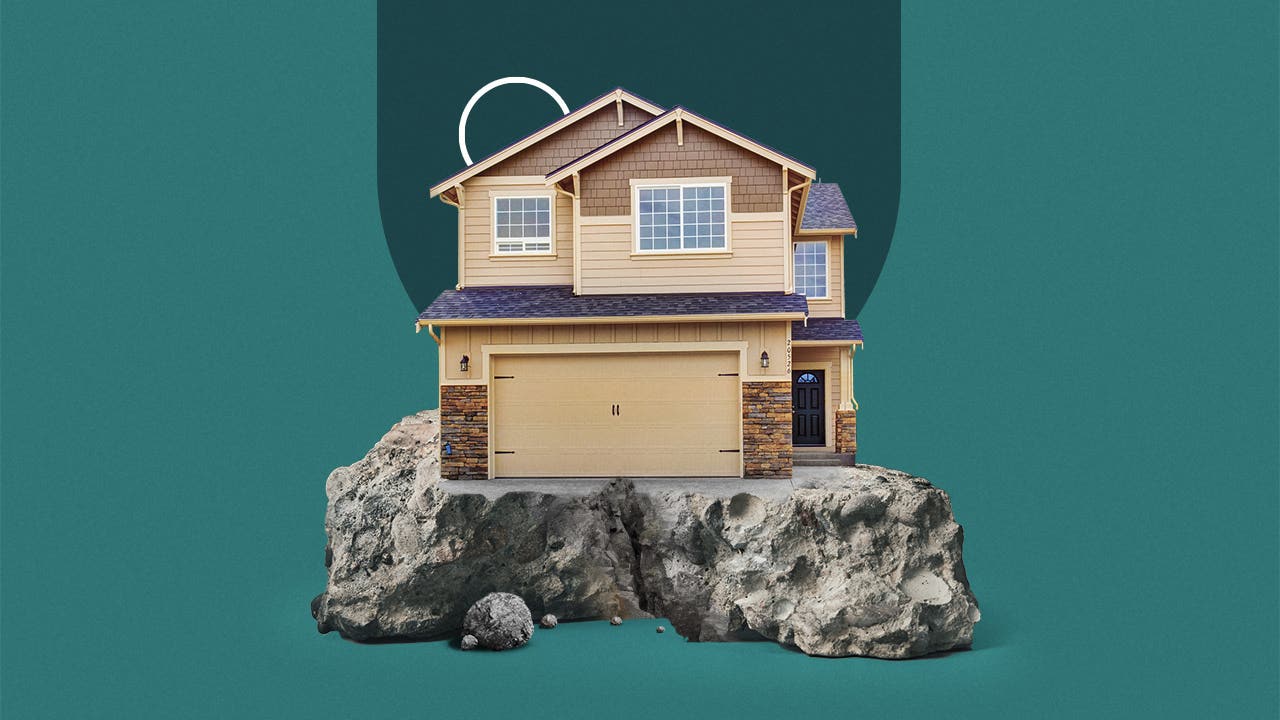Is the housing market going to crash? What the experts are saying

The Bankrate promise
At Bankrate we strive to help you make smarter financial decisions. While we adhere to strict , this post may contain references to products from our partners. Here's an explanation for .
Key takeaways
- Mortgage rates are high, but home prices keep rising — blame the lack of housing supply.
- Economists predict that any market correction will be modest and not on the scale of the Great Recession.
- Experts do not expect a housing market crash, due to low inventory, strict lending standards and other factors.
To the dismay of would-be homebuyers, property prices just keep rising. It seems nothing — not even some of the highest mortgage rates of the past two decades — can stop the continued climb of home prices. Are they destined for a fall? Here’s what the experts say about a potential housing market crash.
Market fluctuations
The U.S. housing market had finally started slowing in late 2022, and home prices seemed poised for a correction. But a strange thing happened on the way to the housing market crash: Home values started rising again. So much for the now-quaint notion that the post-pandemic “housing recession” would reverse some of the outsized price gains in homes.
Prices hit a new all-time high in May, according to the National Association of Realtors (NAR), which reports that median existing-home prices were up 5.8 percent over last year — the 11th month in a row of year-over-year jumps. May 2024’s median of $419,300 surpassed the previous record high of $413,800, reached in June 2022. (Seasonal fluctuations in home prices typically make late spring the highest-priced time of the year.)
Prices will remain firm and will not decline on a national level.— Lawrence Yun, Chief Economist, National Association of Realtors
In another reflection of ongoing increases, the S&P CoreLogic Case-Shiller home price index for April was up 6.3 percent from a year earlier, also reaching an all-time high.
Supply and demand
The main driver of record home prices is a one-two punch straight from Econ 101 — a lack of housing supply coupled with strong demand. Inventories remain frustratingly tight, with NAR’s May data showing only a 3.7-month supply. Not even high mortgage rates have slowed price appreciation. For instance, in October 2023, home values held steady even as mortgage rates soared to 8 percent, reaching their highest levels in more than 23 years. (They have since dipped, falling briefly below 7 percent before averaging 7.04 percent in Bankrate’s weekly survey released July 10.)
The fundamental reason for the run-up in price is heightened demand and a lack of supply.— Greg McBride, CFA , chief financial analyst for Bankrate
“You’re not going to see house prices decline,” says Rick Arvielo, head of mortgage firm New American Funding. “There’s just not enough inventory.”
Skylar Olsen, chief economist at Zillow, agrees about the supply-and-demand imbalance. She predicts home prices will keep rising this year — welcome news for sellers but not so great for first-time buyers struggling to become homeowners. “We’re not in that space where things are suddenly going to be more affordable,” Olsen says.
In fact, the trend is quite the opposite. According to Realtor.com’s May 2024 Housing Market Trends Report, high mortgage rates have increased the monthly cost of financing the typical home (after a 20 percent down payment) by 7.1 percent since last year. That equates to about $158 more in monthly payments than a buyer last May would have seen — a significant jump.
Taking all this into account, housing economists and analysts agree that any market correction is likely to be modest. No one expects price drops on the scale of the declines experienced during the Great Recession.
Is the housing market going to crash?
No. There are still far more buyers than sellers, and that means a meaningful price decline can’t happen: “There’s just generally not enough supply,” says Mark Fleming, chief economist at title insurer First American Financial Corporation. “There are more people than housing inventory. It’s Econ 101.”
Dave Liniger, the founder of real estate brokerage RE/MAX, says the sharp rise in mortgage rates has skewed the market. Many would-be buyers have been waiting for rates to drop — but if mortgage rates do decline meaningfully, it could send new buyers flooding into the market, pushing up home prices.
“You’ve got an entire generation of pent-up demand,” Liniger says. “We’re in this fascinating position of tremendous demand and too little inventory. When interest rates do start to come down, it’ll be another boom-and-bust cycle.”
NAR’s Yun notes that some once-hot markets, like Austin, Texas, have seen small declines in prices. But he sees little chance of falling prices on a broader scale. “Prices will remain firm and will not decline on a national level,” he said.
- According to Bankrate’s weekly national survey of large lenders, the average mortgage interest rate on a 30-year loan was 7.04 percent as of July 10.
- Existing-home sales fell 0.7 percent from April to May and 2.8 percent from May 2023 to May 2024, the National Association of Realtors says.
- The nationwide median sale price in May was $419,300, NAR says. That’s an all-time high — the highest median NAR has ever recorded.
- In May, the housing market had a 3.7-month supply of housing inventory, a 6.7 percent improvement over April but still below the 5 to 6 months needed for a healthy, balanced market — one that favors neither buyers nor sellers.
- A total of 18,574 U.S. homes had foreclosure filings — default notices, scheduled auctions or bank repossessions — in June 2024, according to the latest numbers from ATTOM Data Solutions. That’s down a significant 22.7 percent year-over-year. Illinois had the highest foreclosure rate of any state in June, at one foreclosure filing for every 3,041 housing units.
Back in 2005 to 2007, the U.S. housing market looked downright frothy before home values crashed, with disastrous consequences. When the real estate bubble burst, the global economy plunged into the deepest downturn since the Great Depression. Now that the recent housing boom has been threatened by skyrocketing mortgage rates and lingering fears of a potential recession — Bankrate’s most recent expert survey puts the odds at 33 percent — buyers and homeowners are asking, when will the housing market crash?
However, housing economists agree that it will not crash: Even if prices do fall, the decline will not be as severe as the one experienced during the Great Recession. One obvious difference between now and then is that homeowners’ personal balance sheets are much stronger today than they were 15 years ago. The typical homeowner with a mortgage has stellar credit, a ton of home equity and a fixed-rate mortgage locked in at a low rate — in fact, a New York Times analysis from April found that, at the end of 2023, around 70 percent of U.S. mortgage holders were locked in at rates more than three percentage points below the current market rate at the time.
What’s more, builders remember the Great Recession all too well, and they’ve been cautious about their pace of construction. The result is an ongoing shortage of homes for sale. “We simply don’t have enough inventory,” Yun says. “Will some markets see a price decline? Yes. [But] with the supply not being there, the repeat of a 30 percent price decline is highly, highly unlikely.”
Existing home prices
Economists have long predicted that the housing market would eventually cool as home values become a victim of their own success. After posting a year-over-year decrease in February 2023 for the first time in more than a decade, the median sale price of a single-family home has been on the rise again, reaching the highest price NAR has ever recorded in May 2024.
Overall, home prices have risen far more quickly than incomes. That affordability squeeze is exacerbated by the fact that mortgage rates have more than doubled since August 2021.
Despite prices being high, though, the actual volume of home sales has plunged, and inventories are still too low to meet demand. Homeowners who locked in 3 percent mortgage rates several years ago are declining to sell — and who can blame them, with current rates more than double that? — so the supply of homes for sale is even tighter. As a result, the correction will be nothing like the utter collapse of property prices during the Great Recession, when some housing markets experienced a 50 percent cratering of values.
“We will not have a repeat of the 2008–2012 housing market crash,” Yun said in a statement last fall. “There are no risky subprime mortgages that could implode, nor the combination of a massive oversupply and overproduction of homes.”
Ken H. Johnson, a housing economist at Florida Atlantic University, says the housing market is being pulled in two competing directions. “I think we are in for a period of relatively flat housing price performance around the country as high mortgage rates put downward pressure on prices, while significant demand from household formation and an inventory shortage place upward pressure,” he says. “These forces, for now, should balance each other out.”
5 reasons there will be no housing market crash
Housing economists point to five compelling reasons that no crash is imminent.
- Inventories are still very low: A balanced market typically has a 5- or 6-month supply of housing inventory. NAR says there was just a 3.7-month supply of homes for sale in May (actually quite an improvement — back in early 2022, that figure was a tiny 1.7 months). This ongoing lack of inventory explains why many buyers still have little choice but to bid up prices. And it also indicates that the supply-and-demand equation simply won’t allow a price crash in the near future.
- Builders aren’t building quickly enough to meet demand: Home builders pulled way back after the last crash, and they never fully ramped up to pre-2007 levels. Now, there’s no way for them to buy land and win regulatory approvals quickly enough to quench demand, so a repeat of the overbuilding of 15 years ago looks unlikely. “The fundamental reason for the run-up in price is heightened demand and a lack of supply,” says Greg McBride, Bankrate’s chief financial analyst. “As builders bring more available homes to market, more homeowners decide to sell and prospective buyers get priced out of the market, supply and demand can come back into balance. It won’t happen overnight.”
- Demographic trends are creating new buyers: There’s strong demand for homes on many fronts. Many Americans who already owned homes decided during the pandemic that they needed bigger places, especially with the rise of remote working. Millennials are a huge group and in their prime buying years, and Hispanics are a growing demographic also keen on homeownership.
- Lending standards remain strict: In 2007, “liar loans,” in which borrowers didn’t need to document their income, were common. Lenders offered mortgages to just about anyone, regardless of credit history or down payment size. Today, lenders impose tough standards on borrowers — and those who are getting a mortgage overwhelmingly have excellent credit. The median credit score for new mortgage borrowers in the the first quarter of 2024 was an impressive 770, the Federal Reserve Bank of New York says. “If lending standards loosen and we go back to the wild, wild west days of 2004-2006, then that is a whole different animal,” says McBride. “If we start to see prices being bid up by the artificial buying power of loose lending standards, that’s when we worry about a crash.” Quite the opposite: A recent Federal Reserve survey of senior loan officers reveals that lending standards have actually tightened even further in anticipation of heightened demand when rates eventually drop.
- Foreclosure activity is muted: In the years after the housing crash, millions of foreclosures flooded the housing market, depressing prices. That’s not the case now. Most homeowners have a comfortable equity cushion in their homes. Lenders weren’t filing default notices during the height of the pandemic, pushing foreclosures to record lows in 2020. And while there has been an uptick in foreclosures since then, it’s nothing like it was.
All of that adds up to a consensus: Yes, home prices are pushing the bounds of affordability. But no, this boom shouldn’t end in bust.
FAQs
-
Actually, most industry experts do not expect it to. Housing economists point to five main reasons that the market will not crash anytime soon: low inventory, lack of new-construction housing, large amounts of new buyers, strict lending standards and fewer foreclosures.
-
If you’re hoping to score a good deal, probably not. The current market’s high prices are not expected to drop anytime this year — or at least, not by much. McBride says a plateauing of prices is more likely than a steep fall, and other experts’ housing market predictions for 2024 align with that sentiment. Interest rates remain high as well, so if affordability is a concern, then this might not be the right year for a home purchase.
-
It depends on many factors, including your credit score and how much money you earn versus how much you pay out in debts and expenses each month — known as a debt-to-income ratio. Many financial advisors recommend the 28/36 percent rule of home affordability, which states that you should spend no more than 28 percent of your gross monthly income on housing expenses, and no more than 36 percent on total debt. Bankrate’s home affordability calculator can help you crunch the numbers.
Related Articles



